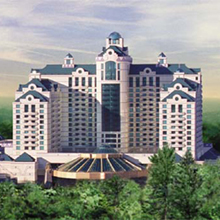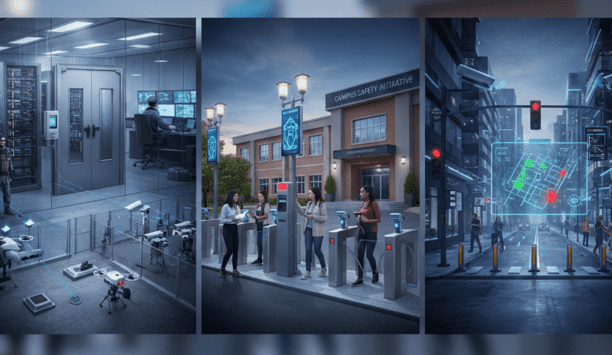 |
| The distributed nature of 1024 switch allows casino staff to place equipment around property and pull cable to nearest rack room |
Digital done on a grand scale
The world’s largest casino resort — Connecticut’s Foxwoods — undergoes the largest analogue-to-digital recording conversion ever undertaken. Without the luxury of downtime, everyone associated with the project works as a single mind to pull off the massive upgrade, which includes a new state-of-the-art control room. The approach offers integrators a way to ease the transition to digital for their customers.
For most people, the gaming industry consists of four easily identifiable segments. Las Vegas brings glitter and neon lights to mind. Atlantic City is synonymous with the celebrity of Donald Trump. European casinos conjure up images of lavishly appointed private clubs, with debonair secret agents strutting around in tuxedos. Native American casinos also have their own unique characteristics. “Native American casinos, as a group, tend to be more on the forefront of technology,” says Chris Greco, president of manufacturers’ representative firm Intelligent Marketing Inc. in Haverhill, Mass. “They are privately held and interested in using the latest that technology has to offer. They’re not afraid to try new things and are generally willing to go through the necessary transition if a future payback is clear. This is particularly true at Foxwoods.”
The Foxwoods he speaks of is the largest resort casino in the world. Connecticut’s Foxwoods Casino Resort features more than 315,000 square feet of gaming space in a complex that covers 4.7 million square feet. Opened in 1986 by the Mashantucket Pequot Tribal Nation as a high-stakes bingo hall, Foxwoods has grown to include six casinos, 7,000+ slot machines and 350 gaming tables. The bingo hall remains an important part of the facility, as does a high-tech race book.
Since more than 40,000 guests visit Foxwoods each day, the safety of patrons and protection of tribal assets is a high priority for Maureen C. Sebastian, chief surveillance officer for the Mashantucket Pequot Tribal Nation. That’s why the complex has spared no expense to complement its personnel, policies and procedures with the best available electronic security solutions.
To that end, the venue recently underwent a significant upgrade to a massive video surveillance system that included converting to digital recording and building a new, state-of-the-art control room. Keeping Foxwoods’ security intact while transitioning to the new system tested the limits of the facility’s management and staff, as well as the project’s manufacturer’s rep, manufacturer, systems integrator and independent consultant.
Need for digital recording, 2nd control room spur upgrades
Expansion of Foxwoods’ video surveillance system has been an ongoing process. Starting with an American Dynamics 1024 matrix switching system, the system has grown to six separate but interconnected “satellite” systems with more than 3,500 inputs. The distributed nature of the switch has allowed casino staff to place equipment around the property and pull cable to the nearest rack room, rather than bringing everything to a central location.
As the size of the system grew, two opportunities for improvement became apparent. First, by continually adding VCRs, the logistics of changing tapes, logging and retrieving video clips, and managing a rotating tape inventory of in excess of 12,000 VHS cassettes became an operational burden. Second, with the sheer amount of gaming activity being monitored by surveillance operators, the hectic pace of calls and activity was more than could be effectively handled in a single surveillance control room.
To rectify both of these issues and accommodate the ever-present facility expansion, Foxwoods decided to bite the bullet and convert its entire video recording operations to digital. At the same time, matrix switch capacity would be expanded to accommodate newly added cameras for a $100 million casino expansion, and a new additional surveillance control room would be built at the other end of the facility. This would allow Foxwoods to run two completely redundant monitoring rooms simultaneously.
 |
| American Dynamics’ Intellex digital video management system allows operator to search for video segments and view them as video clips |
Adding to the challenge, all of this work, including the transition from analogue to digital video, would be performed while the facility was open and operational. There would be no downtime.
“Expanding and converting to digital were strategic decisions that were heavily researched and carefully considered,” elaborates Tim Bohr, surveillance director for Foxwoods. “Tribal Council is eager to remain state-of-the-art and utilise the best products and technologies available, provided the return on investment can be justified.”
In the case of selecting a digital recording vendor, more than 30 different digital video platforms were examined during a two-year evaluation and planning stage, with the decision ultimately coming down to product features, quality and support. “A conversion of this size had never been done before,” adds Bohr, “and if we were blazing the trail, we wanted to be sure there was plenty of support behind us.”
To ensure this support, a team was assembled that would ultimately include the manufacturers rep organisation, manufacturer, integrator and an independent consultant. During the course of 40 months, this group would plan and execute the largest digital video upgrade ever accomplished.
Multiple-screen layout allows operators to do more with images
The new monitoring room was designed to provide a great deal of flexibility in how it was used. A virtual control room approach was used in which a number of images are projected onto screens for viewing by all of the surveillance operators. The size, configuration, and number of images projected can be changed on the fly to respond to any operational situations.
As display technology evolves, the projectors and associated video processing equipment can be upgraded or replaced without reconfiguring the room. To some extent, this adds an element of future proofing to the system design.
When greater concentration is required, a video image may be moved to one of two screens in front of each operator, allowing them to examine the scene in greater detail. Each operator also has two single-channel digital video recorders (DVRs) that are independent of the main recording system. Chosen for their ease of use, these DVRs provide instant playback on each of their call-up monitors by means of a simple jog/shuttle wheel.
“Our operators were used to the ease of shuttling back and forth on VHS tape, and we wanted to improve on that experience,” remarks Foxwoods Surveillance Technical Manager Michael Gauvin. “This approach allows them to instantaneously go back and review something, while the main digital video system provides more extensive search and review capabilities.”
A third monitor provides access to the system’s computer-based functions. They include report writing software, a facial recognition system, a proprietary “undesirable patron” database and the Intellex digital video management system via Foxwoods’ proprietary network client software. The latter allows the operator to search for video segments and view and download them as video clips that may be burned onto CD or DVD.
The system also features a networked video archive server that allows the operator to store video clips for later review by others. They are organised by date and time, allowing a supervisor to quickly call up and review the activities of a previous shift to ensure operational continuity.
Consoles designed to be flexible, durable, ready for future
The console’s layout is designed to give operators enough separation to be able to focus on the images they are working with, while also allowing them to get a quick second opinion from a co-worker or supervisor.
Each room has a main operator console that supports the various activities of surveillance operators. These consoles are monitored by a secondary console, which is manned by a shift manager. The secondary console can also be quickly converted into additional operator stations when the need and casino activity requires additional manpower.
“Expanding and converting to digital were strategic decisions that were heavily researched and carefully considered" |
The consoles were designed to withstand the rigors of constant use, down to the Corian® countertops and side panels.
“We wanted the console to outlast the monitors and other equipment, and the work surface is often the first to go,” adds Gauvin. “The initial outlay may be greater for Corian, but we’ll definitely see a payback over time.”
To ensure the consoles were installed without damage to this specialised work surface, Minneapolis-based console manufacturer Winsted had its factory personnel assist with setting up the consoles, including installing and polishing the countertops.
Functionality wins out as LCDs dropped in favour of CRTs
The original design called for liquid crystal display (LCD) monitors, but was modified to include two cathode ray tube (CRT)-based monitors for video call-up, with a third LCD monitor for the computer hosting the digital video playback.
“Foxwoods wasn’t happy with the quality of the LCD monitors for close examination of video,” explains Jerry Brocki, president of ACP Engineering Inc., the project’s Plainville, Conn.-based systems integrator. “We had initially installed LCD monitors everywhere, but we wound up having reliability problems — the monitors we had used just weren’t holding up to 24/7 usage. When we decided to replace the LCD monitors, we looked at other models, but the more we looked the more we were convinced CRTs still look better.”
While some of the differences could be attributed to personal preference, it became clearer that the range of adjustment on CRT monitors allowed Foxwoods to fine-tune the image to bring out detail in shadows without saturating the lighter colours. No one was willing to sacrifice functionality for the sleeker look of flat panel displays.
“The main objective for both surveillance monitor rooms was the best working system available, housing the friendliest equipment to be used by the operators,” asserts Bohr. “While flat screens looked more impressive, CRTs provided the quality and functionality the operation needed. Looks don’t catch the crooks.”
Adjustments put in place for additional 120 DVRs
To convert Foxwoods from analogue to digital, it was necessary to run both systems simultaneously for a period of time. To accomplish this, a new DVR rack room was built adjacent to the new control room that would house roughly half of the DVRs in specially constructed, 10-foot-high racks. The signals that would feed these DVRs were from cameras in a rack room about 350 feet away from the new room.
It was decided that unshielded, twisted pair (UTP) technology would be used rather than coaxial, which would take up too much conduit space, or fibre, which was too costly and hard to justify for a short run. Nitek modules and active receivers were chosen, based on a DIP-switch configuration design (rather than rotary adjustments), which allowed easy replication of settings across multiple channels. For greater bandwidth, 25-pair Cat-5e cable was used rather than traditional 25-pair communications grade cable.
Once the new DVRs were wired and accepted, a portion of the VCRs in the existing VCR rack room were removed. This allowed the second phase to begin — the installation of 120 additional DVRs, bringing the total to more than 250. Initially, as these DVRs were installed and brought online section by section, the VCRs they were replacing were removed, allowing for the installation of additional DVRs. When the system was completed, all cameras would be recorded digitally with a significant amount of empty rack space in each of the DVR rooms available for future expansion.
"The main objective for both surveillance monitor rooms was the best working system available, housing the friendliest equipment to be used by the operators" |
“An added advantage of this system is the ability to record all our cameras on a full-time basis,” states Bohr. “Prior to this conversion, roughly 25 percent of our cameras were recorded using a combination of 1:1 recording, quads and multiplexers. Today, close to 100 percent of our cameras are recorded.”
Manufacturer, consultant weigh in to further customise the system
As the DVRs came online, American Dynamics (AD) of San Diego monitored the way Foxwoods used the systems. “The further into the project we got, the more we realised there was a need to customise the environment for an operation of this magnitude,” asserts Tim Chuppe, regional sales manager for AD. “There were features Foxwoods had on its wish list that we realised would improve the product for all of our customers.”
Ultimately, it became a function of Egg Harbor Township, N.J.-based independent consulting firm R. Grossman and Associates (RG&A) — as the project manager — to work with Foxwoods and AD’s software development team to define, document and implement these added features.
Temperature was a concern from the very beginning, and a great deal of time was spent planning the proper system ventilation. With more than 275 computers in use, including 2,900 hard drives with almost 600,000GB of data constantly in use, the DVR rooms were cooled to an ambient temperature of 68º F. While this prevented any product failures due to thermal conditions, technicians needed to wear jackets to work in the room for extended periods. “It’s like working in a ‘clean room’ without the bunny suit,” remarks Gauvin.
Another issue was the data network. As the project went from design to completion, certain technologies that may have been prohibitively expensive at the onset suddenly became affordable. As the first DVR room came online, it became apparent there would be a significant improvement in file transfers if a gigabit backbone were implemented between the network switches that connected the DVRs.
“We already had a fibre link between the two rooms, but we felt we should use gigabit between switch boxes to avoid problems in the future when usage became heavier,” confirms Brocki. The result was extremely fast data transfer that exceeds today’s requirements but will easily allow for future growth.
Project comes to a close, but upgrades ongoing for client
The upgrade had been completed. However, experience has taught everyone on the project team that future growth at Foxwoods is assured.
Throughout the installation, everyone was encouraged to look at expansion and plan accordingly. From ensuring every cable was labelled and documented, to adding empty racks for expansion and oversizing the electrical and cooling systems, all eyes are to the future. When you have a forward-thinking client like the Foxwoods Casino Resort, no one wants to be left behind.
Robert Grossman has spent more than 15 years in the industry and is president of R.Grossman and Associates (RG&A), a consulting group in Egg Harbor Township, N.J., specialising in electronic security products and projects. He is also a columnist for Security Sales and Integration.
Author’s note
“While I am currently the project manager for the Foxwoods expansion described in this article, I am a relatively recent addition to the project team in that role. When this project started, I was leading the Applications Engineering team at American Dynamics (AD) and, as such, was heavily involved in the design and specification of the system, including the control room design. As the project progressed, my career path at AD moved me to product line management responsibilities, which pulled me away from day to day involvement with Foxwoods.
As the DVRs came online, American Dynamics (AD) of San Diego monitored the way Foxwoods used the systems |
When I made the decision to become an independent consultant in February 2004, I was contracted to handle project management responsibilities for the remainder of the project. This included overseeing software modifications to customise the digital recording system for Foxwoods, ensure all open issues for the first phase of the project were documented and resolved, and handle final design and construction of the second phase of the project, as outlined in the story.
As the author of this story, it is difficult to quote myself in the project manager’s role. Where appropriate, I have interjected my professional observations into the story, but used the words of others on the project team to emphasise points. It has been the high point of my career to work with an organisation as professional as Foxwoods.” — Robert D. Grossman
Project’s team concept helps all parties win
In a “project team” approach, all stakeholders in a project are brought together throughout the planning, construction and commissioning of the system. By carefully defining the roles and ensuring a solid commitment from all parties, the mentality shifts from documenting blame in case things go wrong to helping each other avoid problems in the first place. This was the approach taken for the Foxwoods Casino Resort project.
Members of the Foxwoods project team included: Foxwoods — As the system owner, Foxwoods management was responsible for determining the system requirements and selecting products that best meet their needs. They handled the physical construction and modification of the various rooms, including electrical, HVAC and fire suppression systems. With the hectic nature of managing a large construction project around a working surveillance room, there were numerous last minute decisions that needed to be made on the spot. “Being more formal in the design process would have allowed us to avoid some problems,” says Foxwoods Surveillance Director Tim Bohr “But overall, it’s hard to imagine a project of this size running more smoothly.”
American Dynamics (AD) — The San Diego-based equipment designer and manufacturer provided equipment, overall project management and technical support, and made whatever product changes that were needed. This included modifying software to add features that Foxwoods had suggested, to ultimately benefit other AD customers. “The commitment they have shown to Foxwoods is second to none,” declares Bohr.
Intelligent Marketing Inc. (IMI) — As the Haverhill, Mass.-based manufacturer’s representative, IMI is “the face of the manufacturer,” according to Bohr. IMI was on-site extensively throughout the planning phase of the project and was heavily involved in defining features that were required for Foxwoods to consider a specific digital solution. IMI’s local presence and knowledge of the product and capabilities provided valuable continuity as the project moved from design to construction to final commissioning.
ACP Engineering Inc. — With extensive experience at Foxwoods and a solid, local engineering and installation team, Plainville, Conn.-based ACP was the ideal systems integrator for the project. The integrator was instrumental in getting custom material fabricated and in place, including 10-foot-high racks in one of the DVR rooms.
ACP was also involved in facilitating the decision-making process by orchestrating numerous product “shoot-outs” to help Foxwoods make its final selections. To select flat-panel LCD monitors, for example, more than 35 separate models were reviewed and tested.
R.Grossman and Associates (RG&A) — As an independent consultant, Egg Harbor Township, N.J. - based RG&A was brought in midway through the project to close out the first phase and ensure smooth operation on the second phase. “When roadblocks were encountered during the project, AD hired an independent consultant on our behalf,” says Bohr. “If that doesn’t emphasise the team approach, I don’t know what does.”
From facial recognition to LiDAR, explore the innovations redefining gaming surveillance





















